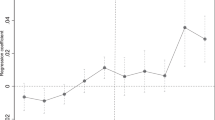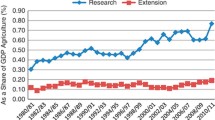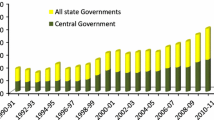Abstract
The public sector is an important source of agricultural research as many of the producers are individual farmers who cannot bear the cost of research and development. Public institutes for experimentation, research, and extension called Kohsetsushi help local producers in agriculture and manufacturing improve productivity through various technology transfer channels. Based on the concept of the agricultural innovation system, this study examines whether research effort allocation of agricultural Kohsetsushi in a region smoothly responses to changes in specialization of the region, whether their research efforts are conducive to innovation, and whether determinants and impacts of their research activities vary across products. The results of panel estimation reveal that research effort allocation is responsive to changes in specialization of a region, which suggests the feedback mechanism mediated by extension staff in the region. Agricultural Kohsetsushi act as a significant source of agricultural product innovations, with researchers allocated in different fields exhibiting different levels of elasticity across products.

Source: Author’s own elaboration
Similar content being viewed by others
Notes
Unless otherwise explicitly stated, the author treats “Kohsetsushi” as plural because of their diversity in terms of size, location, history, functions (i.e., research, technology diffusion, and intermediation), technologies, organizational structures, and ownership structures.
Examples of technology diffusion programs similar to manufacturing Kohsetsushi include the Manufacturing Extension Partnership (MEP) in the US, the Industrial Research Assistance Program (IRAP) in Canada, the Steinbeis Foundation in Germany, Regional Board for Economic Development (ERVET) in Emilia-Romagna of Italy, Technology Innovation Centres (TIC) in the UK, and the Netherlands Organisation for Applied Scientific Research (TNO) (Shapira et al. 2011).
Specifically, in prefectures where innovative activities of local SMEs concentrate in the field of biotechnology, manufacturing Kohsetsushi are more likely to employ licensing because innovations in biotechnology build on “analytical knowledge” that is easily codified in the form of documents, and thus they are better transferred via less interpersonal channels. On the other hand, in prefectures where innovative activities of local SMEs concentrate in the field of mechanical engineering, manufacturing Kohsetsushi are more likely to conduct technical consultation because innovations in mechanical engineering build on “synthetic knowledge” that is hard to codify, and thus personal interactions are required for them to be diffused.
Agbamu (2000) and Sugino (2003) describe organizational structures of agricultural Kohsetsushi, but these studies are not analytical. Takemura et al. (2014) provide evidence on the impact of regional embeddedness of extension workers on users’ problem solving in the fishing village, but the research scope does not encompass other agricultural fields.
The first agricultural Kohsetsushi were established in 1871 in Hokkaido and Tokyo, under the guidance of Horace Capron, a foreign advisor of the Meiji Government. See Fukugawa and Goto (2016) for a historical review of Kohsetsushi.
In Japan, the Plant Variety Protection and Seed Act enacted in 1998 provides legal protection to a new cultivar. The 1998 version has been entirely revised in response to the International Convention for the Protection of New Varieties of Plants (UPOV) of 1991.
The number of public extension staff is 6,558 as of 2015 while that of JA who are engaged in extension is 13,893. The total number of JA staff is 204,516, approximately half of which engage in finance and insurance.
Examples of such needs include the development of heat-tolerant varieties in response to climate change and automated equipment and facilities in response to the advent of labor-shortage economy.
The “innovation roadmap” laid out by the higher echelon encourages agricultural Kohsetsushi to develop products and technologies that may not be immediately payable for most of the local agricultural entrepreneurs, but would eventually contribute to the regional AIS. This route of knowledge diffusion is depicted as the thinnest arrows in Fig. 1. As will be discussed later, these moves also could lead the transformation of the regional AIS.
The system approach to agricultural innovation and technology transfer is hardly new. See Klerkx et al. (2012) for the conceptual evolution of the AIS.
Another reason for this practice to be adopted by many local authorities is that the feedback mechanism encourages agricultural Kohsetsushi to respond local research needs, which renders their research output not necessarily ready for the nationwide diffusion.
Trade association, an example of a private innovation intermediary, help participating firms in the same industry share knowledge regarding new opportunities, managerial practices, and technological standards so that they could improve productivity, thereby acting as a broker and resource provider in sectoral innovation systems. The agricultural sector consists of a number of individual farmers, making public innovation intermediaries more important for knowledge sharing and technology transfer.
“Entrepreneurial networking” of innovation intermediaries proposed in the present study is the combination of three key activities (demand articulation, network brokerage, and innovation process management) of innovation intermediaries in the AIS, identified by Klerkx and Leeuwis (2008).
Major motivations for the private sector to patent inventions include (in order of importance) commercial exploitation (prevention of imitation and inventing around), appropriation by exclusion (blocking), defense (to use own patents), licensing (cross licensing and royalty), and reputation (Nagaoka and Walsh 2009).
They include bean, flower, fruit, industrial crop, millet, potato, rice, vegetable, wheat, and others.
See Table 3 for a list of prefectures.
Another major criticism is that patents are highly heterogeneous in their value or quality.
This also suggests that technical consultation is critical for the assessment of manufacturing Kohsetsushi. See Fukugawa and Goto (2016).
Using such a weight was necessary to have Rfield vary across plants. This builds on the assumption that the allocation of research efforts of a region across fields is identical across plants. For instance, if problems in rice production in a region are dealt with research on plant protection and soil analysis with efforts spared evenly, those in vegetable show the identical tendencies. This may not hold true if different products exhibit problems with very different natures.
They include plant breeding, breeding of livestock, cultivation and physiology, soil and fertilizer, plant protection, feedstuff, sanitation of livestock, life science, environmental science, metrology, civil engineering, machinery, information processing, processing, preserving, and distribution of foods, and management.
They include rice, wheat, soy, sugar cane, sugar beet, sweet potato, potato, feedstuff, fruit, vegetable, flower, tea, other plants, cattle, swine, chicken, other livestock, new industry, and commons.
The research and development lag varies not only across products, but also across research fields with plant breeding indicating the longest lag (Qian et al. 1997). The latter cannot be incorporated in this study due to data limitations.
A new drug as a product innovation is rigorously defined by universal language like chemical equations, and thus, can be easily codified in the form of patents. A drug discovery tends to be standalone innovation, as opposed to systemic innovation that requires a number of complementary technologies to define a final product. These features make it difficult for followers to invent around, and thus make patents a very effective method for innovators to appropriate innovative returns.
More than ninety percent of vegetable distributed in Japan is F1.
The creation of stock variables representing human capital related to agricultural research and extension that accumulates and depreciates over time is a research agenda for future study.
References
Agbamu, J. (2000). Agricultural research-extension linkage systems: An international perspective. Agricultural Research & Extension Network Paper No. 106, July 2000.
Al-Sharafat, A., Altarawneh, M., & Altahat, E. (2012). Effectiveness of agricultural extension activities. American Journal of Agricultural and Biological Sciences, 7(2), 194–200.
Andersen, M. (2015). Public investment in U.S. agricultural R&D and the economic benefits. Food Policy, 51, 38–43.
Arundel, A., van de Paal, G., & Soete, L. (1995). Innovation strategies of Europe’s largest industrial firms: Results of the PACE survey on information sources, public research, protection of innovations, and government programmes. Maastricht: MERIT.
Cohen, W., Nelson, R., & Walsh, J. (2000). Protecting their intellectual assets: Appropriability conditions and why U.S. manufacturing firms patent (or not). NBER Working Paper No. 7552.
del Carmen, D. R., & Bautista, O. K. (2016). Nature and extent of extension delivery on postharvest handling of horticultural perishables in the Philippines. Asian Journal of Agriculture and Development, 13(1), 87–103.
Elzen, B., Barbier, M., Cerf, M., & Grin, J. (2012). Stimulating transitions towards sustainable farming systems. In I. Darnhofer, D. Gibbon, & B. Dedieu (Eds.), Farming systems research into the 21st century: The new dynamic (pp. 431–455). New York: Springer.
Elzen, B., Geels, F. W., Leeuwis, C., & van Mierlo, B. (2011). Normative contestation in transitions “in the making”: Animal welfare concerns and system innovation in pig husbandry. Research Policy, 40(2), 263–275.
Fan, S. (2000). Research investment and the economic returns to Chinese agricultural research. Journal of Productivity Analysis, 14, 163–182.
Fracasso, A., & Marzetti, G. (2018). Estimating dynamic localization economies: The inadvertent success of the specialization index and the location quotient. Regional Studies, 52(1), 119–132.
Fukugawa, N. (2016). Knowledge creation and dissemination by Kosetsushi in sectoral innovation systems: Insights from patent data. Scientometrics, 109(3), 2303–2327.
Fukugawa, N. (2017). University spillover before the national innovation system reform in Japan. International Journal of Technology Management, 73(4), 206–234.
Fukugawa, N. (2018). Division of labor between innovation intermediaries for SMEs: Productivity effects of interfirm organizations in Japan. Journal of Small Business Management, 56(S1), 297–322.
Fukugawa, N., Ambashi, M., & Suhud, Y. (2018). Division of labour amongst innovation intermediaries in agricultural innovation systems: The case of Indonesia. ERIA Discussion Paper, Jakarta: Economic Research Institute of ASEAN and East Asia (ERIA).
Fukugawa, N., & Goto, A. (2016). Problem solving and intermediation by local public technology centers in regional innovation systems: The first report on a branch-level survey on technical consultation. RIETI Discussion Paper 16-E-062.
Goto, A., & Nagata, A. (1997). Technological opportunities and appropriating the returns from innovation. Tokyo: National Institute of Science and Technology Policy.
Grillitsch, M., Hansen, T., Coenen, L., & Miörner, J. (2019). Innovation policy for system-wide transformation: The case of strategic innovation programmes (SIPs) in Sweden. Research Policy, 48(4), 1048–1061.
Hayami, Y., & Ruttan, W. (1985). Agricultural development: An international perspective (Revised ed.). Baltimore: Johns Hopkins University Press.
Howells, J. (2006). Intermediation and the role of intermediaries in innovation. Research Policy, 35(5), 715–728.
Huffman, W., & Evenson, R. (2006). Do formula or competitive grant funds have greater impacts on state agricultural productivity? American Journal of Agricultural Economics, 88(4), 783–798.
Japan Association for the Advancement of Research Cooperation. (2011). Survey on Kohsetsushi in regional innovation systems. Tokyo: JAREC.
Jarmin, R. (1999). Evaluating the impact of manufacturing extension on productivity growth. Journal of Policy Analysis and Management, 18(1), 99–119.
Jin, Y., & Huffman, W. (2016). Measuring public agricultural research and extension and estimating their impacts on agricultural productivity: New insights from U.S. evidence. Agricultural Economics, 47, 15–31.
Kassem, H. S. (2014). Effectiveness of different agricultural extension methods in providing knowledge and skills in disease prevention: A case of smallholder poultry production systems in Dakhalia Governorate of Egypt. Asian Journal of Agricultural Extension, Economics and Sociology, 3(2), 91–107.
Klerkx, L., & Leeuwis, C. (2008). Matching demand and supply in the agricultural knowledge infrastructure: Experiences with innovation intermediaries. Food Policy, 33(3), 260–276.
Klerkx, L., van Mierlo, B., & Leeuwis, C. (2012). Evolution of systems approaches to agricultural innovation: Concepts, analysis and interventions. In I. Darnhofer, D. Gibbon, & B. Dedieu (Eds.), Farming systems research into the 21st century: The new dynamic (pp. 457–483). New York: Springer.
Knickel, K., Brunori, G., Rand, S., & Proost, J. (2009). Towards a better conceptual framework for innovation processes in agriculture and rural development: From linear models to systemic approaches. The Journal of Agricultural Education and Extension, 15(2), 131–146.
Lamine, C. (2011). Transition pathways towards a robust ecologization of agriculture and the need for system redesign: Cases from organic farming and IPM. Journal of Rural Studies, 27(2), 209–219.
Levin, R., Klevorick, A., Nelson, R., & Winter, S. (1984). Survey research on R&D appropriability and technological opportunity. New Haven, CT: Yale University Press.
Link, A., & Hasselt, M. (2019). A public sector knowledge production function. Economics Letters, 175, 64–66.
Nagaoka, S., & Walsh, J. (2009). Commercialization and other uses of patents in Japan and the U.S.: Major findings from the RIETI-Georgia Tech Inventor Survey. RIETI Discussion Paper 09-E-011.
Ponds, R., Oort, F., & Frenken, K. (2010). Innovation, spillovers and university–industry collaboration: An extended knowledge production function approach. Journal of Economic Geography, 10(2), 231–255.
Qian, K., Fan, S., & Zhu, X. (1997). Post and ex-ante evaluation of agricultural research and efficient, allocation of research resources. Beijing: China Agricultural Scientech Press.
Schot, J., & Steinmueller, E. (2016). Framing innovation policy for transformative change: Innovation policy 3.0. Working Paper, University of Sussex, Brighton.
Shapira, P., Youtie, J., & Kay, L. (2011). Building capabilities for innovation in SMEs: A cross-country comparison of technology extension policies and programmes. International Journal of Innovation and Regional Development, 3(3–4), 254–272.
Sorensen, T. (2011). Australian agricultural R&D and innovation systems. International Journal of Foresight and Innovation Policy, 7, 192–212.
Stankiewicz, R. (1995). The role of the science and technology infrastructure in the development and diffusion of industrial automation in Sweden. In B. Carlsson (Ed.), Technological systems and economic performance: The case of factory automation (pp. 165–210). Kluwer: Dordrecht.
Sugino, T. (2003). Integration of agricultural research and extension. Tokyo: Asian Productivity Organization.
Takemura, K., Uchida, Y., & Fujino, M. (2014). Extension officers as social coordinators: Comparisons between agricultural and fishing communities in Japan. Psychologia, 57(4), 245–258.
Vellema, S. (2008). Postharvest innovation in developing societies: The institutional dimensions of technological change. Stewart Postharvest Review, 4(2), 1–8.
World Bank. (2012). Agricultural innovation systems: An investment sourcebook. Washington, DC: World Bank.
Acknowledgements
This research was funded by the Japan Society for the Promotion of Science [16KK0070], the Japan Securities Scholarship Foundation, the Casio Science Promotion Foundation, and the Asahi Group Foundation.
Author information
Authors and Affiliations
Corresponding author
Rights and permissions
About this article
Cite this article
Fukugawa, N. Determinants and impacts of public agricultural research: product-level evidence from agricultural Kohsetsushi in Japan. Scientometrics 120, 1475–1498 (2019). https://doi.org/10.1007/s11192-019-03158-0
Received:
Published:
Issue Date:
DOI: https://doi.org/10.1007/s11192-019-03158-0
Keywords
- Agricultural innovation systems
- Innovation intermediaries
- Japan
- Kohsetsushi
- Location quotients
- New variety of a plant
- Panel data
- Product innovations
- Technology transfer




